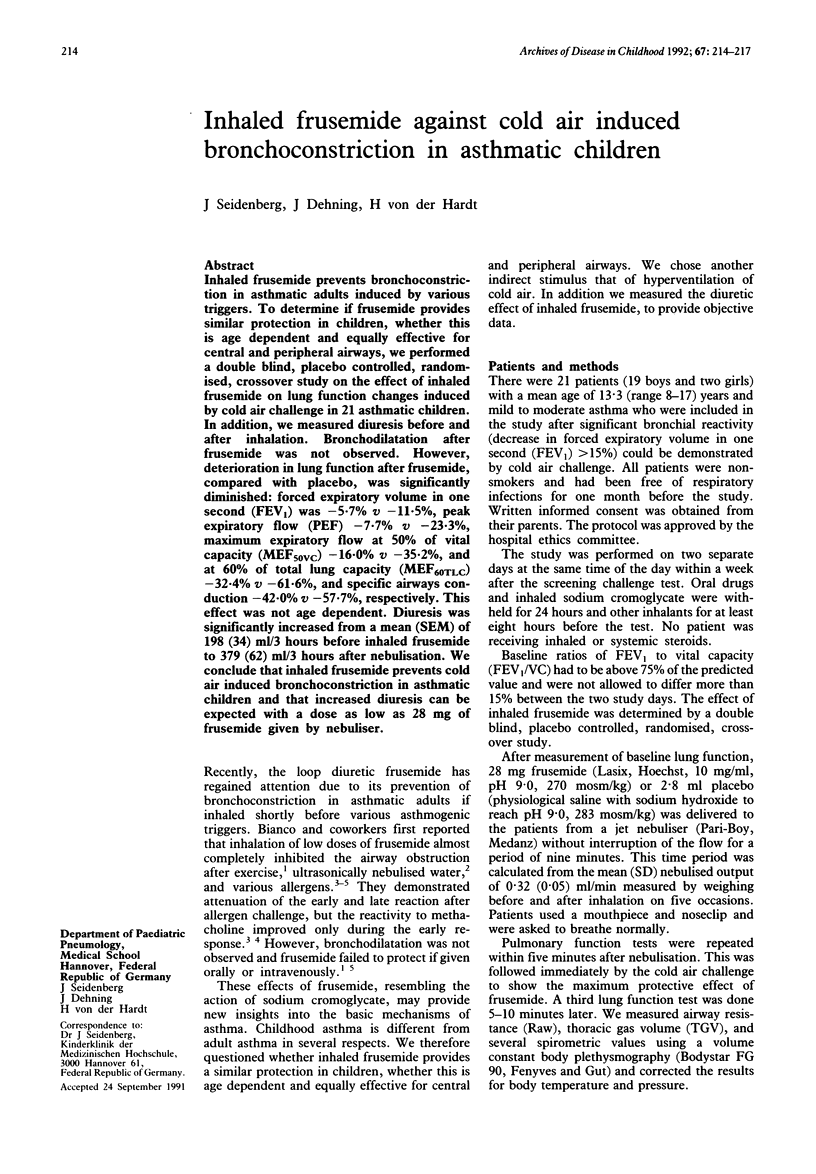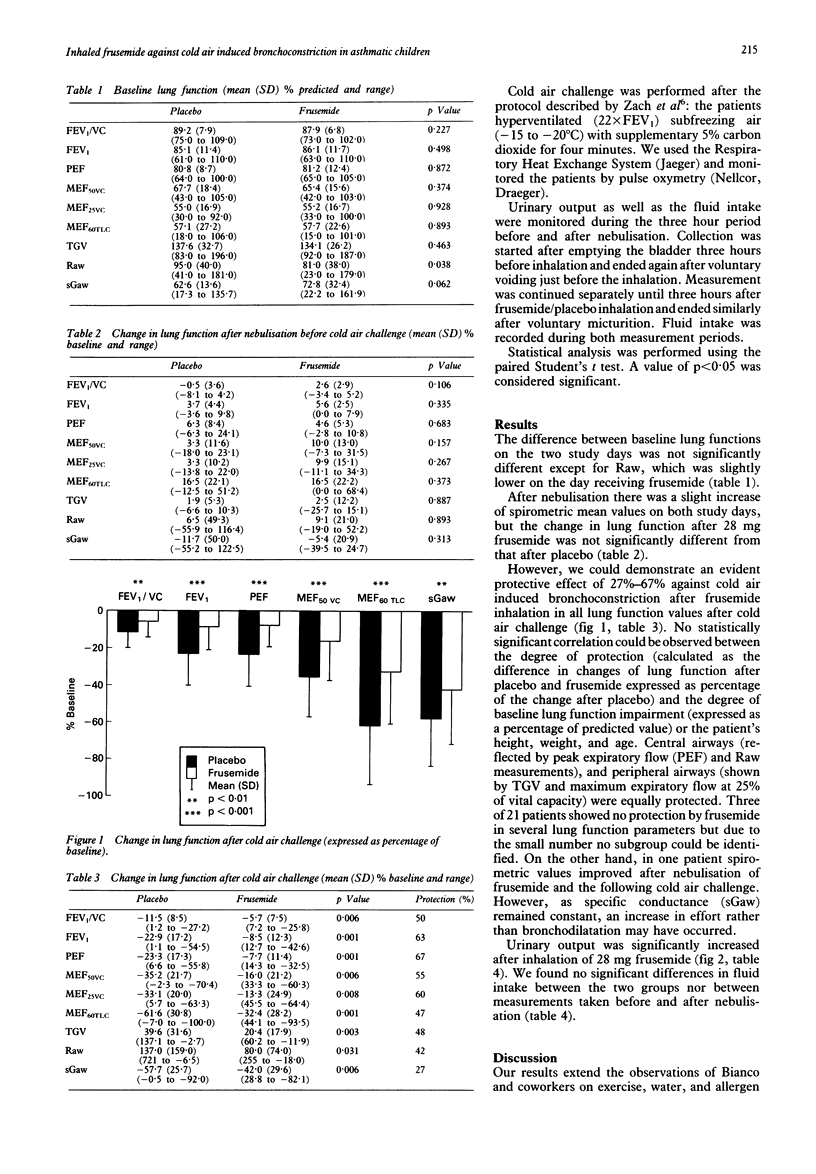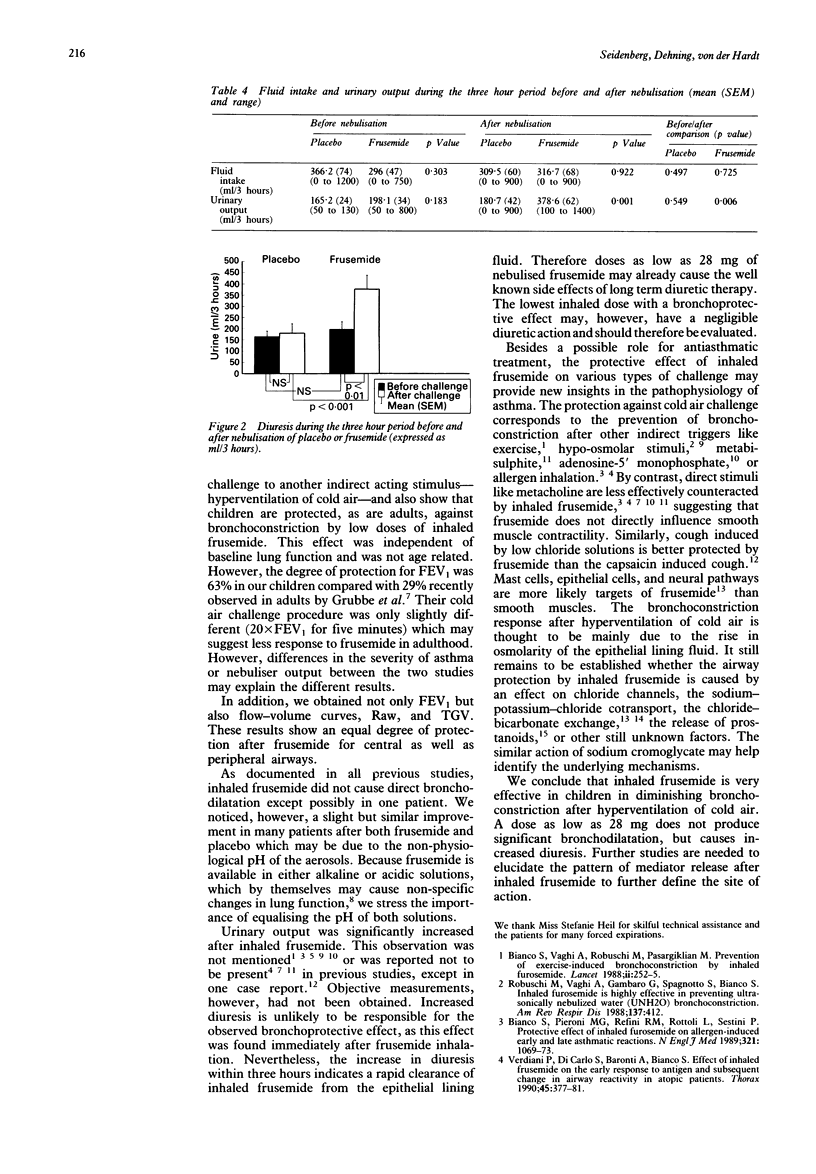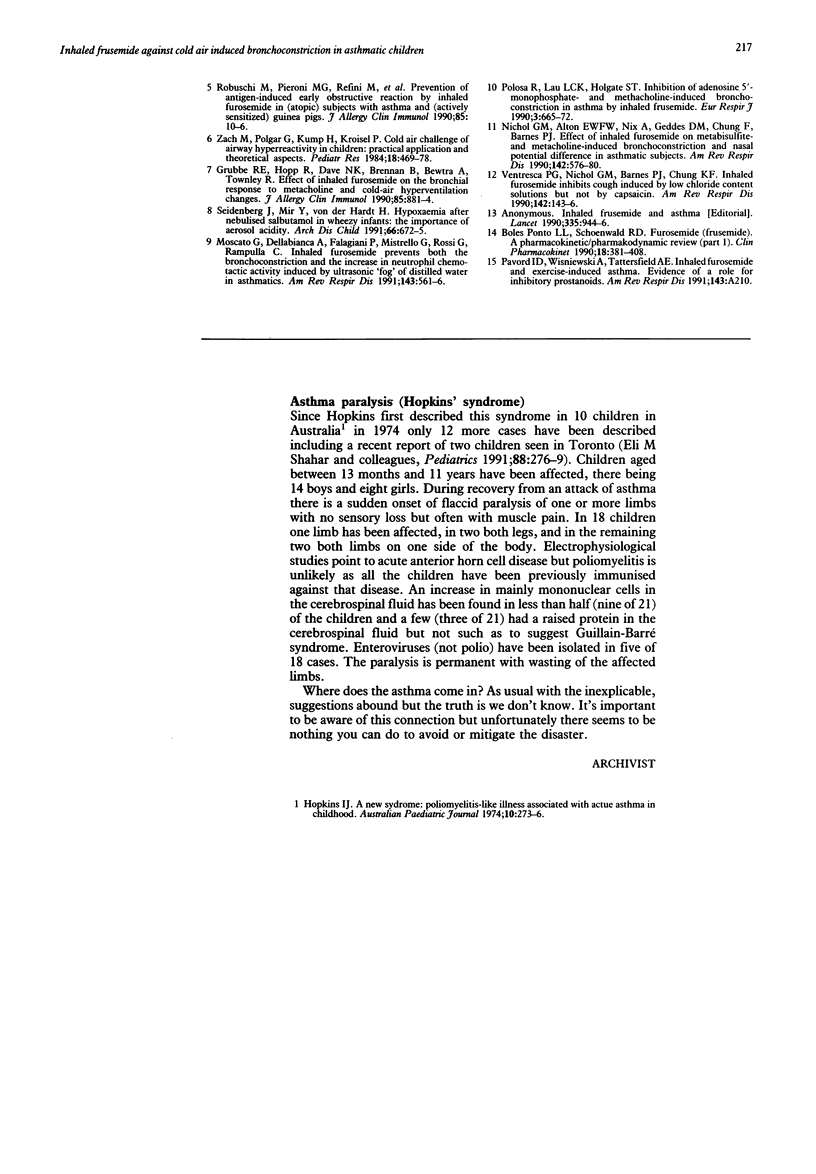Abstract
Inhaled frusemide prevents bronchoconstriction in asthmatic adults induced by various triggers. To determine if frusemide provides similar protection in children, whether this is age dependent and equally effective for central and peripheral airways, we performed a double blind, placebo controlled, randomised, crossover study on the effect of inhaled frusemide on lung function changes induced by cold air challenge in 21 asthmatic children. In addition, we measured diuresis before and after inhalation. Bronchodilatation after frusemide was not observed. However, deterioration in lung function after frusemide, compared with placebo, was significantly diminished: forced expiratory volume in one second (FEV1) was -5.7% v -11.5%, peak expiratory flow (PEF) -7.7% v -23.3%, maximum expiratory flow at 50% of vital capacity (MEF50VC) -16.0% v -35.2%, and at 60% of total lung capacity (MEF60TLC) -32.4% v -61.6%, and specific airways conduction -42.0% v -57.7%, respectively. This effect was not age dependent. Diuresis was significantly increased from a mean (SEM) of 198 (34) ml/3 hours before inhaled frusemide to 379 (62) ml/3 hours after nebulisation. We conclude that inhaled frusemide prevents cold air induced bronchoconstriction in asthmatic children and that increased diuresis can be expected with a dose as low as 28 mg of frusemide given by nebuliser.
Full text
PDF



Selected References
These references are in PubMed. This may not be the complete list of references from this article.
- Bianco S., Pieroni M. G., Refini R. M., Rottoli L., Sestini P. Protective effect of inhaled furosemide on allergen-induced early and late asthmatic reactions. N Engl J Med. 1989 Oct 19;321(16):1069–1073. doi: 10.1056/NEJM198910193211602. [DOI] [PubMed] [Google Scholar]
- Bianco S., Vaghi A., Robuschi M., Pasargiklian M. Prevention of exercise-induced bronchoconstriction by inhaled frusemide. Lancet. 1988 Jul 30;2(8605):252–255. doi: 10.1016/s0140-6736(88)92540-8. [DOI] [PubMed] [Google Scholar]
- Chapman H. A., Jr, Reilly J. J., Jr, Kobzik L. Role of plasminogen activator in degradation of extracellular matrix protein by live human alveolar macrophages. Am Rev Respir Dis. 1988 Feb;137(2):412–419. doi: 10.1164/ajrccm/137.2.412. [DOI] [PubMed] [Google Scholar]
- Elliott S., Morton R. E., Whitelaw R. A. Atlantoaxial instability and abnormalities of the odontoid in Down's syndrome. Arch Dis Child. 1988 Dec;63(12):1484–1489. doi: 10.1136/adc.63.12.1484. [DOI] [PMC free article] [PubMed] [Google Scholar]
- Grubbe R. E., Hopp R., Dave N. K., Brennan B., Bewtra A., Townley R. Effect of inhaled furosemide on the bronchial response to methacholine and cold-air hyperventilation challenges. J Allergy Clin Immunol. 1990 May;85(5):881–884. doi: 10.1016/0091-6749(90)90072-c. [DOI] [PubMed] [Google Scholar]
- McManners T. Odontoid hypoplasia. Br J Radiol. 1983 Dec;56(672):907–910. doi: 10.1259/0007-1285-56-672-907. [DOI] [PubMed] [Google Scholar]
- Moscato G., Dellabianca A., Falagiani P., Mistrello G., Rossi G., Rampulla C. Inhaled furosemide prevents both the bronchoconstriction and the increase in neutrophil chemotactic activity induced by ultrasonic "fog" of distilled water in asthmatics. Am Rev Respir Dis. 1991 Mar;143(3):561–566. doi: 10.1164/ajrccm/143.3.561. [DOI] [PubMed] [Google Scholar]
- Nichol G. M., Alton E. W., Nix A., Geddes D. M., Chung K. F., Barnes P. J. Effect of inhaled furosemide on metabisulfite- and methacholine-induced bronchoconstriction and nasal potential difference in asthmatic subjects. Am Rev Respir Dis. 1990 Sep;142(3):576–580. doi: 10.1164/ajrccm/142.3.576. [DOI] [PubMed] [Google Scholar]
- Polosa R., Lau L. C., Holgate S. T. Inhibition of adenosine 5'-monophosphate- and methacholine-induced bronchoconstriction in asthma by inhaled frusemide. Eur Respir J. 1990 Jun;3(6):665–672. [PubMed] [Google Scholar]
- Ponto L. L., Schoenwald R. D. Furosemide (frusemide). A pharmacokinetic/pharmacodynamic review (Part I). Clin Pharmacokinet. 1990 May;18(5):381–408. doi: 10.2165/00003088-199018050-00004. [DOI] [PubMed] [Google Scholar]
- Seidenberg J., Mir Y., von der Hardt H. Hypoxaemia after nebulised salbutamol in wheezy infants: the importance of aerosol acidity. Arch Dis Child. 1991 Jun;66(6):672–675. doi: 10.1136/adc.66.6.672. [DOI] [PMC free article] [PubMed] [Google Scholar]
- Shahar E. M., Hwang P. A., Niesen C. E., Murphy E. G. Poliomyelitis-like paralysis during recovery from acute bronchial asthma: possible etiology and risk factors. Pediatrics. 1991 Aug;88(2):276–279. [PubMed] [Google Scholar]
- Ventresca P. G., Nichol G. M., Barnes P. J., Chung K. F. Inhaled furosemide inhibits cough induced by low chloride content solutions but not by capsaicin. Am Rev Respir Dis. 1990 Jul;142(1):143–146. doi: 10.1164/ajrccm/142.1.143. [DOI] [PubMed] [Google Scholar]
- Verdiani P., Di Carlo S., Baronti A., Bianco S. Effect of inhaled frusemide on the early response to antigen and subsequent change in airway reactivity in atopic patients. Thorax. 1990 May;45(5):377–381. doi: 10.1136/thx.45.5.377. [DOI] [PMC free article] [PubMed] [Google Scholar]
- Zach M., Polgar G., Kump H., Kroisel P. Cold air challenge of airway hyperreactivity in children: practical application and theoretical aspects. Pediatr Res. 1984 May;18(5):469–478. doi: 10.1203/00006450-198405000-00016. [DOI] [PubMed] [Google Scholar]


